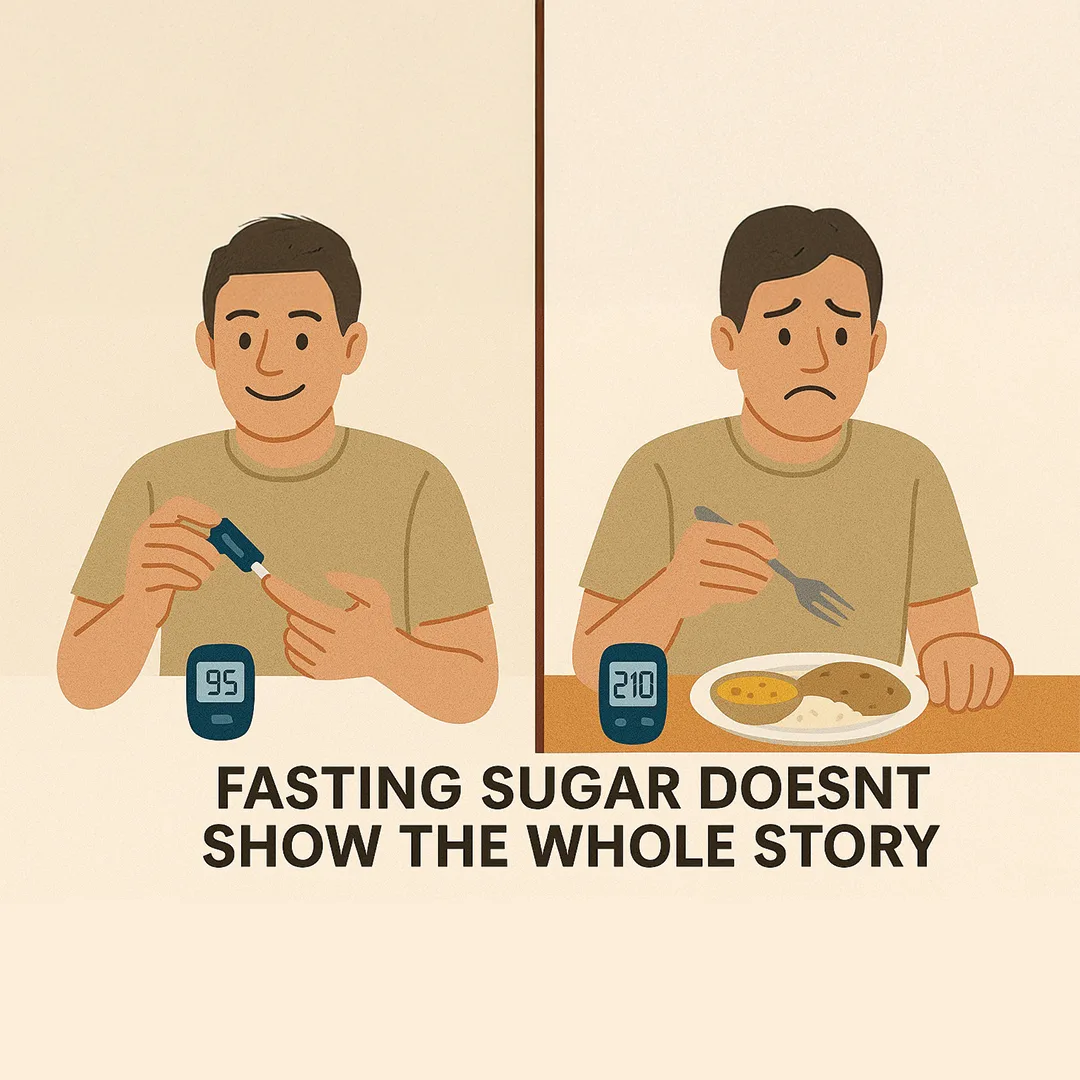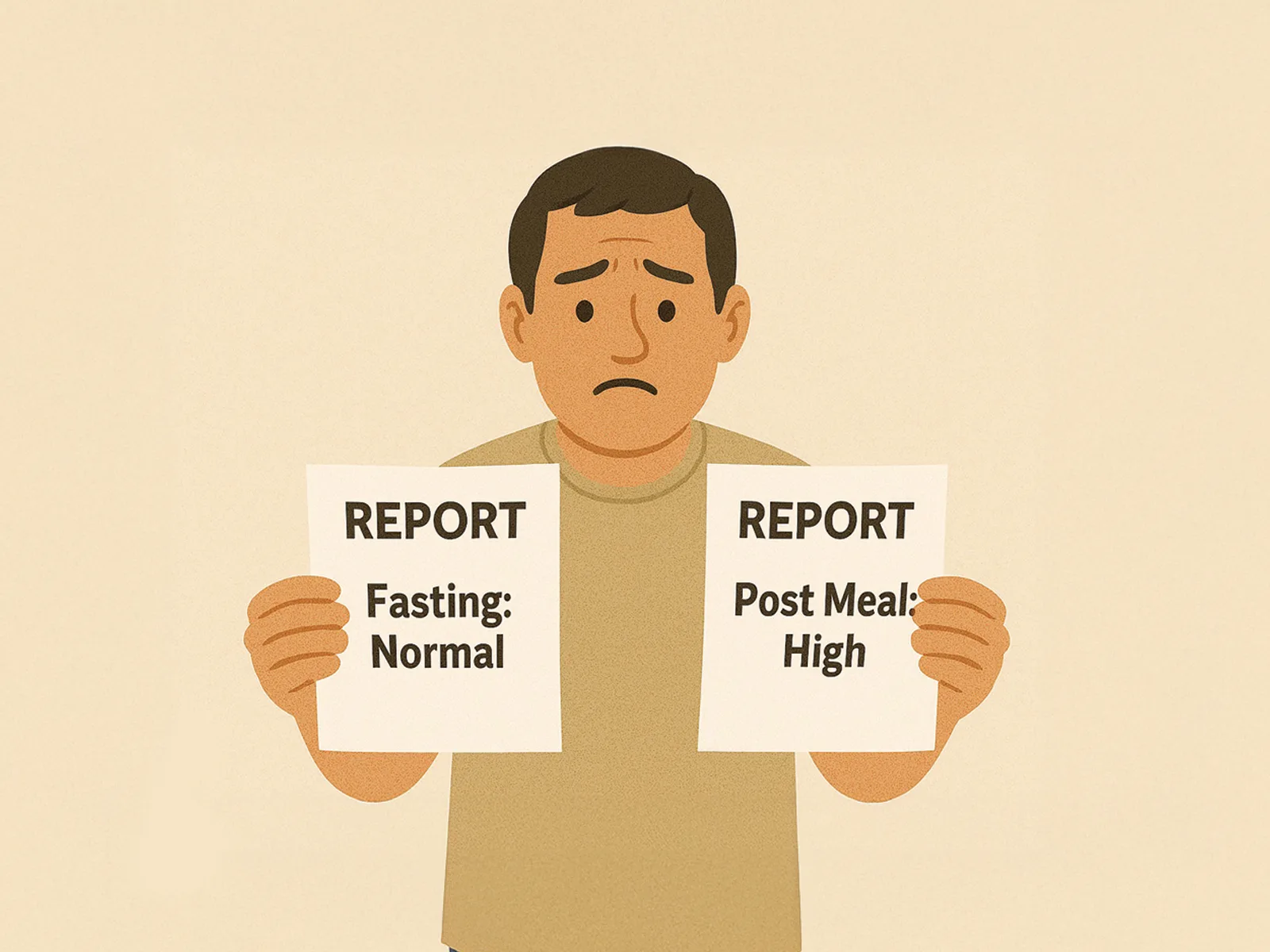Rajesh’s Story: A Wake-Up Call for Every Diabetic
Rajesh, a 45-year-old banker from Delhi, walked into Redial Clinic with a wide smile and a file in his hand.
“Doctor, I think I’m fine now. My fasting blood sugar came back at 97 mg/dL. That’s normal, right?”
On the surface, Rajesh seemed to be doing well. He had type 2 diabetes for three years, was on two tablets, and recently had started walking every morning. But he often complained of extreme fatigue after lunch, frequent thirst, and a tingling sensation in his feet. Something didn’t add up.
We recommended two additional tests: postprandial blood sugar (PPBS) and HbA1c (glycated hemoglobin). The results shocked him:
- Fasting Blood Sugar (FBS): 97 mg/dL (Normal)
- Postprandial Blood Sugar (PPBS): 238 mg/dL (High)
- HbA1c: 7.4% (Diabetes)
Rajesh was stunned. “How is this possible? If my fasting is normal, how can I still have diabetes?”
This is the exact misconception many patients in India carry — that a normal fasting sugar means their diabetes is under control. In reality, fasting blood sugar and diabetes management are not the same thing. Relying on fasting alone can create a false sense of security while post-meal sugar spikes silently damage the body.
What Fasting Blood Sugar Really Means
Fasting blood sugar is the glucose level measured after at least 8 hours without food. It tells us how your body maintains sugar balance overnight, primarily reflecting liver glucose output.

Current Diagnostic Cutoffs (ADA 2024 & ICMR Guidelines):
- Normal: Less than 100 mg/dL
- Prediabetes (Impaired fasting glucose): 100–125 mg/dL
- Diabetes: 126 mg/dL or higher, confirmed on repeat testing
On paper, Rajesh’s fasting sugar of 97 mg/dL looked “normal.” But the truth is, diabetes is not only about fasting levels. Many people, especially Indians with a higher tendency for insulin resistance, can maintain normal fasting numbers while experiencing dangerous spikes after meals.
Postprandial Blood Sugar: The Hidden Danger
Postprandial blood sugar (PPBS) is the blood glucose measured two hours after a meal.
Current Cutoffs (ADA 2024 & ICMR India):
- Normal: Less than 140 mg/dL
- Prediabetes (Impaired glucose tolerance): 140–199 mg/dL
- Diabetes: 200 mg/dL or higher
In Rajesh’s case, his PPBS was 238 mg/dL, which clearly indicated diabetes — despite his fasting being normal.
Why is this important? Because postprandial spikes are the real culprits behind diabetes complications. Research, including the International Diabetes Federation (IDF) guidelines, shows that high PPBS values are strongly linked with:
- Damage to blood vessels (leading to heart attacks and strokes)
- Progression of fatty liver disease
- Accelerated kidney damage (diabetic nephropathy)
- Faster decline in pancreatic beta-cell function
In simple terms: you might wake up with a “good” fasting blood sugar number, but if your sugars shoot up to 220–250 after meals every day, you are still fueling the fire of diabetes.
HbA1c: The Bigger Picture
Another key test for diabetes is HbA1c, which stands for glycated hemoglobin. Unlike fasting or postprandial sugar, which only reflect a moment in time, HbA1c gives the average blood sugar of the past 3 months.
Current ADA / ICMR Cutoffs:
- Normal: Less than 5.5%
- Prediabetes: 5.5–6.4%
- Diabetes: 6.5% or higher
Why A1C is Important
- It shows your long-term blood sugar trends, not just daily ups and downs.
- It predicts the risk of complications like kidney disease, neuropathy, and heart problems better than fasting alone.
- It cannot be manipulated by “one good day” of eating before a test.
In Rajesh’s case, his HbA1c of 7.4% told us that his average blood sugar over 3 months was around 170 mg/dL — far above the healthy target of <117 mg/dL (which corresponds to an HbA1c of ~5.7%).
This is why effective diabetes management requires checking HbA1c along with fasting and postprandial sugar, not just one number.
Random Blood Sugar: A Quick Indicator
Random blood sugar (RBS) is measured at any time of the day, regardless of meals.
Cutoffs (ADA 2024):
- Normal: <140 mg/dL
- Diabetes: ≥200 mg/dL with symptoms of hyperglycemia (excessive thirst, urination, fatigue)
Although not as precise as HbA1c or PPBS, fasting vs random blood sugar comparisons can give a quick snapshot, especially in emergencies. If your random reading is above 200 mg/dL with symptoms, you likely have diabetes and need further evaluation.
Beyond Numbers: Daily Blood Sugar Variability
Even with all these tests, there’s one more critical factor: glucose fluctuations.
Imagine your blood sugar as a rollercoaster. Every time you eat high-carb Indian foods like white rice, poori, or sweets, your sugar shoots up. Then, insulin brings it crashing down, often leaving you tired, hungry, or craving more sugar.
This glycemic variability is dangerous because:
- It damages blood vessels and nerves.
- It worsens oxidative stress and inflammation.
- It speeds up complications like retinopathy, kidney damage, and heart disease.
But how do you measure these fluctuations? That’s where modern glucose monitoring tools come in.
The Role of Glucose Monitoring Tools in Diabetes Care
Continuous Glucose Monitoring (CGM for Diabetes)
A Continuous Glucose Monitor (CGM) is a small wearable device placed on your arm or abdomen. It checks sugar every few minutes and shows a real-time blood sugar levels chart.
Benefits of CGM:
- Reveals hidden sugar spikes after meals.
- Alerts you if your sugar goes too high or too low.
- Helps identify how your body responds to different foods, exercise, and sleep patterns.
- Empowers smart ways to control diabetes by making informed dietary and lifestyle choices.
At Redial Clinic, Green Park, Delhi, we use CGM to guide our patients through a Diabetes Reversal Treatment plan that is personalized and data-driven.
Smart Glucometers and Apps
Not everyone may be ready for a CGM. In that case, smart glucometers with mobile syncing help you track fasting, postprandial, and random sugars. You can generate weekly blood sugar levels charts and share them with your healthcare provider.
Lifestyle & Food Log Tracking
Keeping a habit journal is another important tool in diabetes tracking methods. Write down what you ate, your sleep hours, stress levels, and exercise. When combined with glucose monitoring tools, this creates a clear picture of what’s helping or harming your sugar control.
The Indian Context: Why Post-Meal Sugars Matter Even More
Indian diets are traditionally carbohydrate-heavy — think rice, roti, potatoes, and sweets at every meal. This makes postprandial blood sugar management crucial.
Studies from the Indian Council of Medical Research (ICMR) show that Indians are more prone to central obesity and insulin resistance than many Western populations, meaning our bodies react sharply to carbs.
That’s why, in India, guidelines emphasize checking both fasting and postprandial blood sugar. A person can have a “normal” fasting value but cross the diabetic threshold after a meal. Without checking, these hidden spikes go unnoticed until complications appear.
The Myth of “Normal Fasting Sugar Means You’re Healthy”
This is one of the most common Indian diet myths. Many patients proudly show a fasting blood sugar report below 100 mg/dL and assume everything is fine, ignoring their post-meal values.
But science is clear:
- Fasting blood sugar and diabetes management are not equal.
- You need to track all key parameters — FBS, PPBS, HbA1c, and ideally CGM trends.
- Why A1C is important: it reflects real average sugar control, not just one point in time.
At Redial Clinic, we explain to patients that diabetes reversal treatment is about lowering insulin resistance and overall sugar exposure, not just controlling morning fasting numbers.
Smart Ways to Control Diabetes Beyond Fasting
When patients see their blood sugar levels chart from a CGM, they often realize that it’s not the black coffee, but the lunch-time rice, rotis, and hidden sugars in “healthy snacks” that are causing damage.
We guide them toward smart ways to control diabetes, such as:
- Replacing high-GI carbs with low glycemic breakfast foods like eggs, paneer, or Greek yogurt with berries.
- Including protein-rich breakfast for diabetics to avoid mid-day crashes.
- Adding fiber-rich salads and low-starch vegetables like lauki, tinda, turai, cucumber, and cauliflower.
- Using only healthy fats — desi ghee, extra virgin olive oil, virgin coconut oil, white makkhan.
- Timing meals with intermittent fasting to reduce constant insulin spikes.
- Using glucose monitoring tools to see which foods suit them best.
The Redial Clinic Advantage: Data + Diet + Coaching
At Redial Clinic, the Diabetes Reversal Clinic in Delhi, we go beyond traditional diabetes care. Our approach combines three pillars:
- Advanced Glucose Monitoring Tools
- We use CGM for diabetes to track sugars 24/7.
- Patients get a personalized blood sugar levels chart and a complete analysis of triggers.
- Personalized Nutrition for Indian Patients
- We design sustainable meal plans based on your lifestyle, culture, and food preferences.
- Both vegetarian and non-vegetarian options are included, from diabetic breakfast Indian meals to high-protein fish, chicken, or paneer dishes.
- Diabetes Reversal Treatment
- Our focus is not just on “managing” but on reversing diabetes by reducing insulin resistance.
- With a reverse diabetes diet, patients improve cholesterol, reduce fatty liver, and often lower or stop medications.
- Many, like Rajesh, experience higher energy, better sleep, and improved quality of life within 3–6 months.
FAQs
Q1. Is fasting blood sugar enough to monitor diabetes?
No, it’s only one reading. You also need postprandial blood sugar, HbA1c, and sometimes CGM for complete diabetes management.
Q2. What is postprandial blood sugar and why is it important?
It’s your sugar level 2 hours after a meal. High PPBS often signals hidden spikes that increase heart and diabetes complications.
Q3. What is the normal range for fasting and post-meal blood sugar?
- Fasting blood sugar: <100 mg/dL (normal), 100–125 mg/dL (prediabetes), ≥126 mg/dL (diabetes)
- Postprandial blood sugar: <140 mg/dL (normal), 140–199 mg/dL (prediabetes), ≥200 mg/dL (diabetes)
Q4. How often should I test my blood sugar?
For type 2 diabetes (non-insulin): once daily (fasting or after meals) + HbA1c every 3 months.
Q5. Is HbA1c a better marker than fasting blood sugar?
Yes. That’s why A1C is important — it shows your 3-month average sugar and predicts long-term complications.
Q6. What is a CGM and how does it work?
A CGM for diabetes is a small wearable sensor that tracks your sugar every few minutes and gives you a 24-hour blood sugar levels chart.
Q7. Can smart monitoring tools help reverse diabetes?
Yes. With smart ways to control diabetes using CGM, smart glucometers, and habit tracking, you can improve insulin sensitivity and support diabetes reversal treatment.
Q8. Does Redial Clinic use advanced tracking tools?
Yes. At Redial Clinic, Green Park, Delhi, we use CGM to design personalized reversal plans.
Final Verdict
Depending only on fasting blood sugar is like checking just one frame of a movie and assuming you know the whole story. It might look fine on the surface, but behind the scenes, dangerous sugar spikes could be damaging your eyes, kidneys, heart, and nerves.
For effective diabetes management, you need a comprehensive monitoring approach:
- Fasting vs random blood sugar to catch baseline and occasional spikes
- Postprandial blood sugar to check meal response
- HbA1c because it shows your long-term average and explains why A1C is important
- Glucose monitoring tools like CGM for diabetes to track your daily blood sugar levels chart and help you adopt smart ways to control diabetes
At Redial Clinic, Green Park, Delhi, we believe in a complete approach that combines modern monitoring, Indian diet planning, and lifestyle coaching. Our mission is to empower you with a personalized Diabetes Reversal Treatment plan so you can live free from medications and complications.
So, the next time you feel happy about a “normal” fasting report, remember Rajesh’s story. Don’t stop at fasting sugar — go deeper, measure smarter, and take control of your health.
References
| No. | Source | Key Findings |
|---|---|---|
| 1 | American Diabetes Association (ADA). Standards of Medical Care in Diabetes – 2024. Diabetes Care. | Defines diagnostic cutoffs: FBS ≥126 mg/dL, PPBS ≥200 mg/dL, HbA1c ≥6.5% for diabetes. |





